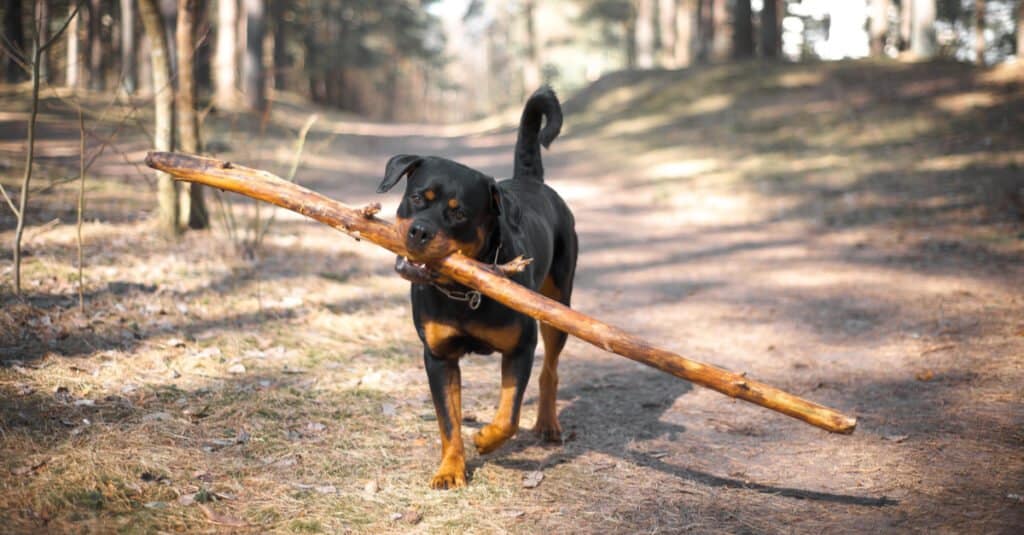When it comes to the Bullmastiff vs the Rottweiler, both are terrific guard dogs. They can be wary of strangers and have stubborn streaks!
Rottweilers have short black coats, are more affectionate and playful with family. Rotties enjoy fast-paced exercises like play or running. Bullmastiffs come in several colors, like moderate exercise like long, daily walks, and may assert their independence during training more often.
Let’s discover what makes these breeds unique in more detail below!
Comparing Bullmastiff vs Rottweiler

| Bullmastiff | Rottweiler | |
|---|---|---|
| Size | 24-27 inches, 100-130 pounds | 22-27 inches, 77-132 pounds |
| Appearance | Stocky, wrinkled skin, short fur in the colors fawn, fawn brindle, red, red brindle, red fawn, and red fawn brindle | Short black fur with mahogany, rust, or tan markings; tail is often docked |
| Lifespan | 7-9 years | 8-10 years |
| Temperament | Very affectionate | Extremely affectionate, playful, adaptable |
| Trainability | Easy | Very easy |
| Energy Level | High | Moderate |
Key Differences Between the Bullmastiff and Rottweiler
The key difference between the Bullmastiff and Rottweiler is appearance. While Rottweilers are always black with markings, bullmastiffs have several color variations.
Other noteworthy differences include size, lifespan, temperament, trainability, and energy level. Let’s dive into these characteristics below to learn more!
Bullmastiff vs Rottweiler: Size

Bullmastiffs tend to be larger than Rottweilers.
©BORINA OLGA/Shutterstock.com
These breeds are similar in size, but Rottweilers tend to be smaller. However, they can grow up to the same height as Bullmastiffs and weigh a bit more on the high end.
Bullmastiffs stand 24-27 inches tall and weigh 100-130 pounds. Rottweilers are 22-27 inches tall and weigh 80-132 pounds.
Rottweilers have much more of a size range!
Bullmastiff vs Rottweiler: Appearance
Both dogs have short muzzles, stocky frames, and floppy ears. However, some key differences set them apart. The first is that Bullmastiffs tend to look more muscular, particularly in the chest.
Second, Bullmastiffs have wrinkled skin on their face and the back of their necks. Ensuring this skin stays healthy is an added grooming task that potential Bullmastiff owners must prepare for.
Rottweilers also have a distinctive characteristic—most of them have docked tails. This is due to the American Kennel Club’s breed standard requiring it. The two breeds also have different fur colors. Rotties are always black with markings of either tan, mahogany, or rust.
Bullmastiffs can be the following colors according to breed standard:
- Fawn
- Fawn brindle
- Red
- Red brindle
- Red fawn
- Red fawn brindle
Bullmastiff vs Rottweiler: Lifespan

Rottweilers live longer than Bullmastiffs and have an average lifespan of 8-10 years.
©iStock.com/Meagan Jenkins
Rottweilers live a few years longer than Bullmastiffs. While Rotties live 8-10 years on average, Bullmastiffs live just 7-9 years.
Of course, some dogs will live years longer than the average—while others will sadly die before the average. The best way to give your dog a good, long life is to provide a high-quality diet, daily exercise, and routine veterinary care.
Bullmastiff vs Rottweiler: Temperament
These are both large guarding breeds, so they have many of the same personality traits. Each loves their family and is slightly wary of strangers. They can have stubborn streaks because they were bred to make independent decisions during their work as guard dogs. It’s important to socialize these breeds early in life so that they gain confidence in new situations and with new people.
Rottweilers tend to be more cuddly and affectionate toward family, but Bullmastiffs are right behind them! Bullmastiffs are still likely to want to be where you are or even right on top of you.
This clinginess has the potential to cause separation anxiety, so it’s best to teach puppies that it’s okay to be alone. Leave them for short periods, keep the experience as positive as possible, and slowly work your way to longer stretches of time.
However, neither of these dogs should be left alone for the majority of the day. They do best in families where someone is home most of the time.
Rottweilers tend to be more playful, while Bullmastiffs are moderately so. They’ll still love a game of fetch like any dog but may not initiate play as often.
Lastly, Rotties are often a bit more adaptable to new situations than Bullmastiffs.
Bullmastiff vs Rottweiler: Trainability

Bullmastiffs tend to be more stubborn and independent.
©OlgaOvcharenko/Shutterstock.com
It’s vital to socialize and train guarding breeds well, as they can easily feel wary of new people, animals, and environments. Though these are smart breeds, you may run into some obstacles when it comes to these things, particularly if the dog wasn’t well socialized as a pup.
That said, both of these breeds are intelligent, fast learners. They each have a stubborn streak—the Bullmastiff most of all—and might struggle for independence during training.
Keep sessions short and positive. Never punish your dog, and end training on a positive note whenever possible. Don’t wait until one or both of you become frustrated with each other!
We recommend positive reinforcement with any dog. High-value rewards like tasty treats will get you further than harsh training methods, and you should avoid any training that requires “dominating your dog” altogether, as this method has long been disproven.
Bullmastiff vs Rottweiler: Energy Level

Rottweilers are more playful, while Bullmastiffs like slower activities such as long walks.
©Mariya Kuzema/Shutterstock.com
Although Rotts tend to be more playful, Bullmastiffs are higher-energy overall. However, they enjoy moderate exercise best.
Bullmastiffs are great for those who want to go on long, leisurely walks with their dog and play in the backyard.
Rottweilers enjoy a wider variety of activities, from swimming to running to hiking trails. Rotties also enjoy having a job to do and have a high need for mental stimulation. Puzzle toys, games of fetch, and hide-and-seek are all great activities to work a Rottweiler’s mind as well as their body. Bullmastiffs will also likely enjoy these activities. It’s good for any breed of dog to engage in things that make them think.
Both dogs benefit from a large, enclosed outdoor space so that they can play and run. Because they can be territorial, a high fence that keeps them enclosed is a must. Make sure your dog cannot jump the fence and mind that people passing by don’t stick their hands inside, as some dogs won’t tolerate this.
The photo featured at the top of this post is © Olga Aniven/Shutterstock.com
Ready to discover the top 10 cutest dog breeds in the entire world?
How about the fastest dogs, the largest dogs and those that are -- quite frankly -- just the kindest dogs on the planet? Each day, AZ Animals sends out lists just like this to our thousands of email subscribers. And the best part? It's FREE. Join today by entering your email below.
Thank you for reading! Have some feedback for us? Contact the AZ Animals editorial team.






